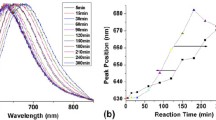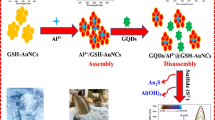Abstract
A ratiometric fluorometric assay for mercury(II) ion is described. It is making use of glutathione-stabilized gold nanoclusters (GSH-AuNCs) modified with tetraphenylporphyrin tetrasulfonic acid (TPPS). The resultant GSH-AuNC/TPPS nanocomposite displays dual emission (at 572 and 664 nm) under a single excitation wavelength of 365 nm. Mercury(II) ion intensively quenches the yellow fluorescence of GSH-AuNCs (peaking at 572 nm) but has a negligible effect on the red fluorescence of TPPS (at 664 nm). The ratio of fluorescence intensities at 572 and 664 nm drops linearly with Hg(II) ion concentration in the 0.02-2.0 μmol·L−1 range, and the detection limit is 7 nmol·L−1 (3sb/S). The relative standard deviation (RSD) of the assay is 2.0% at a 0.5 μmol·L−1 concentration level (n = 11). The method was successfully applied to the determination of Hg(II) ion in spiked water samples, with recoveries within the range of 87.5-107.5%.

Ratiometric fluorescence detection of mercury(II)





Similar content being viewed by others
References
Driscoll CT, Mason RP, Chan HM, Jacob DJ, Pirrone N (2013) Mercury as a global pollutant: source, pathways, and effects. Environ Sci Technol 47:4967-4983. https://doi.org/10.1021/es305071v
Ha E, Basu N, Bose-O’Reilly S, Dorea JG, McSorley E, Sakamoto M, Chan HM (2017) Current progress on understanding the impact of mercury on human health. Environ Res 152:419-433. https://doi.org/10.1016/j.envres.2016.06.042
Li CY, Zhang XB, Qiao L, Zhao Y, He CM, Huan SY, Lu LM, Jian LX, Shen GL, Yu RQ (2009) Naphthalimide-porphyrin hybrid based ratiometric bioimaging probe for Hg2+: well-resolved emission spectra and unique specificity. Anal Chem 81:9993-10001. https://doi.org/10.1021/ac9018445
Sundseth K, Pacyna JM, Pacyna EG, Pirrone N, Thorne RJ (2017) Global sources and pathways of mercury in the context of human health. Int J Env Res Pub He 14:105. https://doi.org/10.3390/ijerph14010105
Bjorklund G, Dadar M, Mutter J, Aaseth J (2017) The toxicology of mercury: current research and emerging trends. Environ Res 159:545-554. https://doi.org/10.1016/j.envres.2017.08.051
Yun W, Li FK, Liu XY, Li N, Chen L, Yang LZ (2018) A catalytic cleavage strategy for fluorometric determination of Hg(II) based on the use of a Mg(II)-dependent split DNAzyme and hairpins conjugated to gold nanoparticles. Microchim Acta 185:457. https://doi.org/10.1007/s00604-018-2990-4
Covaci E, Senila M, Tanaselia C, Angyus SB, Ponta M, Darvasi E, Frentiu M, Frentiu T (2018) A highly sensitive eco-scale method for mercury determination in water and food using photochemical vapor generation and miniaturized instrumentation for capacitively coupled plasmas microtorch optical emission spectrometry. J Anal Atom Spectrom 33:799-808. https://doi.org/10.1039/c8ja00054a
Lopez-Garcia I, Rivas RE, Hernandez-Cordoba M (2012) Hollow fiber based liquid-phase microextraction for the determination of mercury traces in water samples by electrothermal atomic absorption spectrometry. Anal Chim Acta 73:69-74. https://doi.org/10.1016/j.aca.2012.07.015
Jia XY, Han Y, Liu XL, Duan TC, Chen HT (2011) Speciation of mercury in water samples by dispersive liquid-liquid microextration combined with high performance liquid chromatography-inductively coupled with plasma mass spectrometry. Spectrochim Acta B 66:88-92. https://doi.org/10.1016/j.sab.2010.12.003
Chen GH, Chen WY, Yen YC, Wang CW, Chang HT, Chen CF (2014) Detection of mercury(II) ions using colorimetric gold nanoparticles on paper-based analytical devices. Anal Chem 86:6843-6849. https://doi.org/10.1021/ac5008688
Kamali KZ, Pandikumar A, Jayabal S, Ramaraj R, Lim HN, Ong BH, Bien CSD, Kee YY, Huang NM (2016) Amalgamation based optical and colorimetric sensing of mercury(II) ions with silver@graphene oxide nanocomposite materials. Microchim Acta 183:369-377. https://doi.org/10.1007/s00604-015-1658-6
Da Q, Gu YY, Peng XF, Zhang LY, Du SH (2018) Colorimetric and visual detection of mercury(II) based on the suppression of the interaction of dithiothreitol with agar-stabilized silver-coated gold nanoparticles. Microchim Acta 185:357. https://doi.org/10.1007/s00604-018-2899-y
Xuan F, Luo XT, Hsing IM (2013) Conformation-dependent exonuclease III activity mediated by metal ions reshuffling on thymine-rich DNA duplexes for an ultrasensitive electrochemical method for Hg2+ detection. Anal Chem 85:4586-4593. https://doi.org/10.1021/ac400228q
Suherman AL, Tanner EEL, Compton RG (2017) Recent developments in inorganic Hg2+ detection by voltammetry. TRAC-Trend Anal Chem 94:161-172. https://doi.org/10.1016/j.trac.2017.07020
Luo D, Liu SG, Li NB, Luo HQ (2018) Water-soluble polymer dots formed from polyethylenimine and glutathione as a fluorescent probe for mercury(II). Microchim Acta 185:6. https://doi.org/10.1007/s00604-018-2817-3
Zhang RZ, Chen W (2014) Nitrogen-doped carbon quantum dots: facile synthesis and application as a “turn-off” fluorescent probe for detection of Hg2+ ions. Biosens Bioelectron 55:83-90. https://doi.org/10.1016/j.bios.2013.11.074
Peng D, Zhang L, Liang RP, Qiu JD (2018) Rapid detection of mercury ions based on nitrogen-doped grapheme quantum dots accelerating formation of manganese porphyrin. ACS Sensors 3:1040-1047. https://doi.org/10.1021/acssensors.8b00203
Wang X, Yang XF, Wang N, Lv JJ, Wang HJ, Martin MF, Choi BW (2018) Graphitic carbon nitride quantum dots as an “off-on” fluorescent switch for determination of mercury(II) and sulfide. Microchim Acta 185:471. https://doi.org/10.1007/s00604-018-2994-0
Ghasemi E, Hormozi-Nezhad MR, Mahmoudi M (2018) A new strategy to design colorful ratiometric probes and its application to fluorescent detection of Hg(II). Sensors Actuators B 259:894-899. https://doi.org/10.1016/j.snb.2017.12.141
Achadu OJ, Revaprasadu N (2018) Microwave-assisted synthesis of thymine-functionalized graphitic carbon nitride quantum dots as a fluorescent nanoprobe for mercury(II). Microchim Acta 185:461. https://doi.org/10.1007/s00604-018-3004-2
Zhao JJ, Huang MJ, Zhang LL, Zou MB, Chen DX, Huang Y, Zhao SL (2017) Unique approach to develop carbon dot-based nanohybrid near-infrared ratiometric fluorescent sensor for the detection of mercury ions. Anal Chem 89:8044-8049. https://doi.org/10.1021/acs.analchem.7b01443
Xu HY, Zhang KN, Liu QS, Liu Y, Xie MX (2017) Visual and fluorescent detection of mercury ions by using a dually emissive ratiometric nanohybrid containing carbon dots and CdTe quantum dots. Microchim Acta 184:1199-1206. https://doi.org/10.1007/s00604-017-2099-1
Zheng YK, Lai LM, Liu WW, Jiang H, Wang XM (2017) Recent advances in biomedical applications of fluorescent gold nanoclusters. Adv Colloid Interfac 242:1-16. https://doi.org/10.1016/j.cis.2017.02.005
Xie JP, Zheng YG, Yin JY (2010) Highly selective and ultrasensitive detection of Hg2+ based on fluorescence quenching of Au nanoclusters by Hg2+-Au interactions. Chem Commun 46:961-963. https://doi.org/10.1039/b920748a
Wei H, Wang ZD, Yang LM, Tian SL, Hou CJ, Lu Y (2010) Lysozyme-stabilized gold fluorescent cluster: synthesis and application as Hg2+ sensor. Analyst 135:1406-1410. https://doi.org/10.1039/c0an00046a
Qiao YY, Zhang Y, Zhang CH, Shi LH, Zhang GM, Shuang SM, Dong C, Ma HM (2016) Water-soluble gold nanoclusters-based fluorescence probe for highly selective and sensitive detection of Hg2+. Sensors Actuators B 224:458-464. https://doi.org/10.1016/j.snb.2015.10.080
Qi YX, Zhang M, Zhu AW, Shi GY (2015) Terbium(III)/gold nanocluster conjugates: the development of a novel ratiometric fluorescent probe for mercucry(II) and a paper-based visual sensor. Analyst 140:5656-5661. https://doi.org/10.1039/c5an00802f
Liu W, Wang XY, Wang YQ, Li JH, Shen DZ, Kang Q, Chen LX (2018) Ratiometric fluorescence sensor based on dithiothreitol modified carbon dots-gold nanoclusters for the sensitive detection of mercury ions in water samples. Sensors Actuators B 262:810-817. https://doi.org/10.1016/j.snb.2018.01.222
Dai R, Deng WQ, Hu PY, You C, Yang L, Jiang X, Xiong XL, Huang M (2018) One-pot synthesis of bovine serum albumin protected golg/silver bimetallic nanoclusters for ratiometric and visual detection of mercury. Microchem J 139:1-8. https://doi.org/10.1016/j.microc.2018.02.010
Biesaga M, Pyrzynska K, Trojanowicz M (2000) Porphyrins in analytical chemistry, A review. Talanta 51:209-224. https://doi.org/10.1016/S0039-9140(99)00291-X.
Luo Z, Yuan X, Yu Y, Zhang Q, Leong DT, Lee JY, Xie J (2012) From aggregation-induced emission of Au(I)-thiolate complexes to ultrabright Au(0)@Au(I)-thiolate core-shell nanoclusters. J Am Chem Soc 134:16662-16670. https://doi.org/10.1021/ja306199p
Cao DY, Fan J, Qiu JR, Tu YF, Yan JL (2013) Masking method for improving selectivity of gold nanoclusters in fluorescence determination of mercury and copper ions. Biosens Bioelectron 42:47-50. https://doi.org/10.1016/j.bios.2012.10.084
Acknowledgments
This work was supported by the National Natural Science Foundation of China (Grant No. 21675107) and Fundamental Research Funds for the Central Universities (Grant No. GK201801006, GK201802012, GK201806003).
Author information
Authors and Affiliations
Corresponding authors
Ethics declarations
The author(s) declare that they have no competing interests.
Additional information
Publisher’s note
Springer Nature remains neutral with regard to jurisdictional claims in published maps and institutional affiliations.
Electronic supplementary material
ESM 1
(DOCX 262 kb)
Rights and permissions
About this article
Cite this article
Gao, Y., Liu, M., Yue, X. et al. Ratiometric fluorometric determination of mercury(II) by exploiting its quenching effect on glutathione-stabilized and tetraphenylporphyrin modified gold nanoclusters. Microchim Acta 186, 307 (2019). https://doi.org/10.1007/s00604-019-3405-x
Received:
Accepted:
Published:
DOI: https://doi.org/10.1007/s00604-019-3405-x




